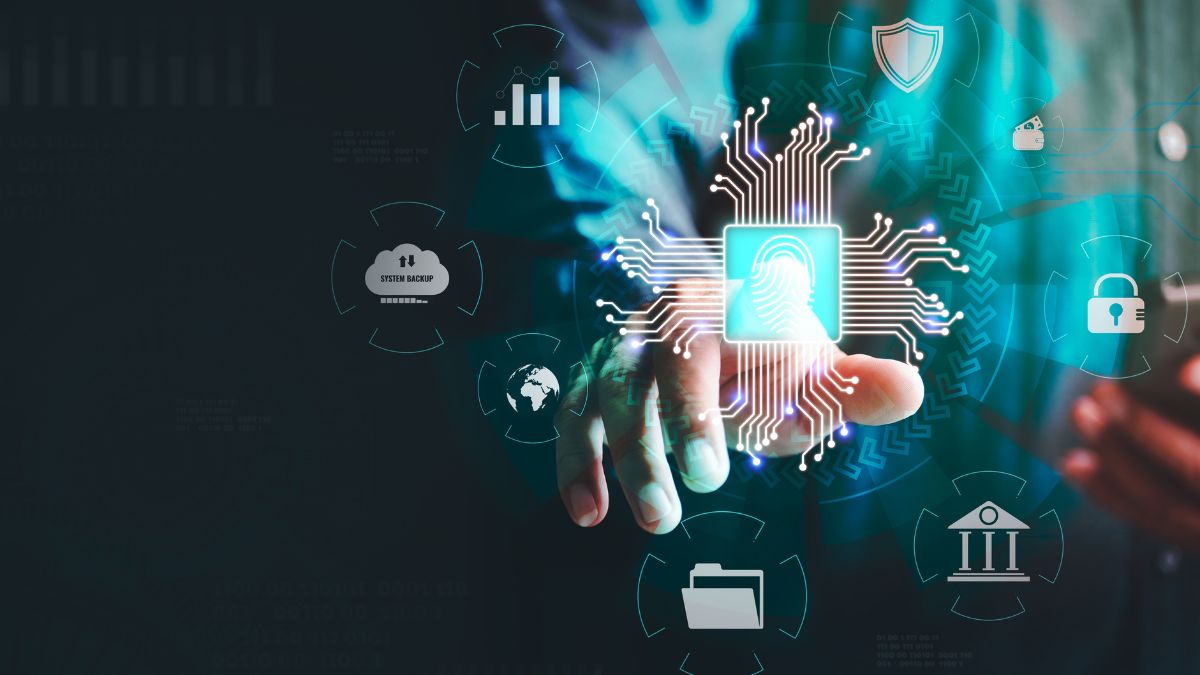Preventing AI from accessing and stealing my personal information is paramount in today’s digital landscape. AI’s increasing sophistication presents novel threats to our data privacy, exploiting vulnerabilities in online accounts, devices, and the apps we use daily. From sophisticated phishing scams to subtle data harvesting techniques, the potential for AI-driven breaches is real and ever-evolving. Understanding these risks and implementing robust protective measures is crucial for safeguarding your personal information.
This guide explores the various avenues through which AI can compromise your data, detailing both common and emerging threats. We’ll delve into practical strategies for securing your online accounts, protecting your devices, and navigating the complexities of sharing data with apps and services. By combining technical safeguards with a proactive approach to online safety, you can significantly reduce your vulnerability to AI-powered data theft.
Understanding Personal Data Vulnerabilities

AI systems, while offering incredible advancements, present significant risks to personal data security. Their ability to process vast amounts of information rapidly and identify patterns makes them powerful tools for both legitimate purposes and malicious activities. Understanding how AI can access and exploit personal data is crucial for mitigating these risks.AI’s potential for accessing personal information stems from its inherent capabilities and the vulnerabilities present in data ecosystems.
AI algorithms can be trained on publicly available datasets containing personal information, inadvertently learning to identify and extract sensitive data from seemingly innocuous sources. Furthermore, AI-powered tools can automate data scraping and phishing attacks, significantly increasing the efficiency and scale of these malicious activities. Weaknesses in data security protocols and poorly implemented privacy measures further exacerbate the problem, creating entry points for AI-driven attacks.
AI Access Methods and Real-World Examples
AI can access personal information through various methods. One common approach involves the use of machine learning models trained on large datasets containing personal information. These models can then be used to identify and extract sensitive data from other datasets, even if that data is not explicitly labeled as such. For instance, an AI model trained on social media posts might learn to infer personal details like addresses or phone numbers from seemingly innocuous comments or photos.
Another method involves the use of AI-powered tools to automate data scraping from websites and applications. These tools can collect vast amounts of personal information in a short period, often bypassing traditional security measures.A real-world example involves the use of AI to identify individuals from facial recognition technology. Several instances have highlighted the potential for misuse, such as unauthorized surveillance or the creation of deepfakes.
Another example involves the use of AI-powered phishing attacks, where AI algorithms are used to create highly personalized phishing emails that are more likely to be successful. The sophisticated nature of these attacks makes them difficult to detect and defend against.
Hypothetical Scenario: AI and Unsecured Data
Imagine a large corporation storing employee personal data – addresses, social security numbers, health records – in a poorly secured cloud database. An AI-powered bot, designed for malicious purposes, discovers this vulnerability. The bot leverages its capabilities to bypass the weak security protocols, gaining access to the database. The AI then uses its pattern recognition capabilities to identify and extract sensitive data points, potentially leading to identity theft, financial fraud, or even physical harm to employees.
This hypothetical scenario highlights the devastating consequences of unsecured personal data in conjunction with the power of AI.
Vulnerable Data Types
Several types of personal information are particularly vulnerable to AI-driven attacks. This includes sensitive data such as financial information (bank account details, credit card numbers), health records (medical history, diagnoses), biometric data (fingerprints, facial recognition data), and personally identifiable information (PII) such as names, addresses, and social security numbers. The unique identifiers within PII are especially attractive to malicious actors seeking to compromise individuals’ identities.
Furthermore, the combination of seemingly innocuous data points can be used by AI to create detailed profiles, enabling highly targeted attacks. The aggregation of seemingly disparate data pieces, often available through various online sources, allows AI to build comprehensive personal profiles, leading to sophisticated forms of identity theft and fraud.
Securing Personal Data Online
Protecting your personal information in the digital age requires a proactive and multi-layered approach, especially given the increasing sophistication of AI-driven attacks. This section details strategies for bolstering your online security and minimizing your vulnerability to AI-based data breaches. Effective security hinges on a combination of strong passwords, robust privacy settings, and multi-factor authentication.
Strong Passwords and Password Management
Creating strong, unique passwords for each online account is crucial. Weak passwords, often reused across multiple platforms, represent a significant vulnerability. AI-powered brute-force attacks can easily crack predictable passwords. A robust password should be at least 12 characters long, incorporating a mix of uppercase and lowercase letters, numbers, and symbols. Furthermore, utilizing a password manager is highly recommended.
These tools generate complex, unique passwords for each account and securely store them, eliminating the need to remember numerous intricate combinations. Password managers often incorporate additional security features, such as multi-factor authentication and breach monitoring.
Social Media Privacy Settings Configuration
Social media platforms collect vast amounts of personal data, making them prime targets for AI-driven data harvesting. Configuring privacy settings effectively minimizes this exposure. A step-by-step guide for a typical platform might include: (1) Reviewing and restricting who can see your posts – limiting visibility to friends or specific groups; (2) Managing tag settings – controlling who can tag you in posts and photos; (3) Disabling location services – preventing applications from accessing your precise location; (4) Limiting data sharing with third-party apps – reviewing and revoking permissions granted to applications; (5) Regularly checking privacy settings updates – social media platforms frequently update their settings; staying informed and making adjustments as needed is crucial.
Implementing these measures significantly reduces the amount of data accessible to AI systems.
Multi-Factor Authentication (MFA) Effectiveness
Multi-factor authentication adds an extra layer of security beyond passwords. It typically involves verifying your identity through a second factor, such as a one-time code sent to your phone or email, or a biometric scan. Even if an attacker obtains your password, they will be unable to access your account without this second verification. MFA significantly hinders AI-driven account takeovers because it requires more than just password cracking.
AI algorithms, while capable of sophisticated attacks, struggle to circumvent this added security measure effectively. Many platforms now offer MFA options, and enabling it should be a priority for all sensitive accounts.
Encryption Methods for Online Data Protection
Encryption transforms readable data into an unreadable format, protecting it from unauthorized access. Various encryption methods exist, each with varying levels of security and complexity. Symmetric encryption uses the same key for both encryption and decryption, offering speed but requiring secure key exchange. Asymmetric encryption, also known as public-key cryptography, uses separate keys for encryption and decryption, enhancing security but sacrificing speed.
End-to-end encryption, used in many messaging apps, ensures only the sender and recipient can access the message content, protecting it from interception even by the service provider. The choice of encryption method depends on the sensitivity of the data and the specific application. For highly sensitive information, strong asymmetric encryption combined with end-to-end encryption offers the highest level of protection.
Managing Personal Information on Devices

Protecting your personal information extends beyond online security; it requires diligent management of data stored on your personal computers and mobile devices. This involves implementing robust security measures to prevent unauthorized access and data breaches, even in the event of device loss or theft. Failing to secure your devices leaves you vulnerable to identity theft, financial fraud, and other serious consequences.Securely storing personal information on personal computers and mobile devices involves a multi-layered approach combining software and hardware solutions.
Strong passwords, regular software updates, and the use of encryption are crucial components of a comprehensive security strategy. This section will Artikel practical steps to enhance your device security and minimize the risk of data compromise.
Secure Data Storage Methods
Employing strong passwords and implementing multi-factor authentication (MFA) are fundamental. Strong passwords should be unique for each account and utilize a combination of uppercase and lowercase letters, numbers, and symbols. MFA adds an extra layer of security, requiring a second form of verification beyond a password, such as a code sent to your phone or email. For sensitive data, consider using a password manager to generate and securely store complex passwords.
Furthermore, regularly updating your operating system and applications patches security vulnerabilities that malicious actors could exploit. Finally, enabling device encryption will scramble your data, making it unreadable without the correct decryption key, even if your device is stolen.
Data Backup and Encryption
Regularly backing up your data is critical for disaster recovery and data protection. Employ the 3-2-1 backup rule: maintain three copies of your data, on two different media types, with one copy stored offsite. This strategy mitigates the risk of data loss due to hardware failure, theft, or natural disasters. Encryption adds another layer of protection by scrambling your backup data, making it inaccessible to unauthorized individuals.
Consider using cloud storage services that offer end-to-end encryption for added security. When selecting a backup solution, prioritize services with strong security features and a proven track record of data protection.
Handling Sensitive Files
Sensitive files, such as financial records, medical information, and legal documents, require extra precautions. Encrypting these files before storing them, either locally or in the cloud, renders them unreadable without the decryption key. Numerous encryption tools are available, ranging from simple password protection to sophisticated encryption software. When deleting sensitive files, avoid simply using the delete command, as this often leaves remnants of the data recoverable through data recovery software.
Instead, utilize secure deletion tools that overwrite the data multiple times, making recovery virtually impossible. Remember to regularly review and update your security protocols as new threats emerge.
Malicious Software Identification and Removal
Malicious software (malware) can compromise your personal information by stealing data, installing keyloggers, or creating backdoors for attackers. Regularly scanning your devices with updated antivirus and anti-malware software is essential. This software can detect and remove various types of malware, including viruses, Trojans, worms, ransomware, and spyware. Be cautious when downloading files from untrusted sources, and avoid clicking on suspicious links or attachments in emails.
Keeping your software updated and employing a firewall can also help prevent malware infections. If you suspect a malware infection, immediately disconnect your device from the internet and seek assistance from a cybersecurity professional.
| Software Type | Risk Level | Mitigation Strategies |
|---|---|---|
| Virus | High | Install and update antivirus software; avoid suspicious websites and downloads. |
| Trojan | High | Install and update antivirus software; exercise caution with email attachments and downloads. |
| Worm | Medium | Install and update antivirus software; regularly update operating systems and applications. |
| Ransomware | High | Regularly back up your data; avoid clicking on suspicious links; install and update antivirus software. |
| Spyware | High | Install and update anti-malware software; review application permissions; use strong passwords. |
Protecting Data Shared with Apps and Services

The proliferation of mobile applications and online services has dramatically increased the amount of personal data we share digitally. This presents significant challenges, particularly in the context of increasingly sophisticated AI systems that can potentially access and misuse this information. Understanding the implications of data sharing and implementing robust protective measures is crucial to maintaining privacy in the digital age.
This section will explore strategies for minimizing the risks associated with sharing personal data with apps and online services, focusing on how these practices can safeguard your information from unauthorized AI access.The seemingly innocuous act of downloading an app or creating an online account often involves granting access to a significant amount of personal information. This data, ranging from contact details and location data to browsing history and financial information, can be exploited for various purposes, some benign and others potentially malicious.
AI algorithms, in particular, can leverage this data to create detailed user profiles, predict behavior, and potentially even manipulate individuals. The potential for misuse, especially when coupled with inadequate data protection measures, highlights the critical need for informed decision-making before sharing personal information.
Factors to Consider Before Sharing Data with Apps and Services
Before granting an app or service access to your personal data, consider the following factors. This proactive approach helps mitigate potential risks associated with data breaches and unauthorized AI access. A thorough assessment ensures you are aware of the potential implications before sharing your information.
- App’s Purpose and Data Requirements: Clearly understand why the app needs specific pieces of personal data. Does the requested information directly relate to the app’s core functionality? If not, question the necessity of the request.
- Data Security Measures: Investigate the app’s data security practices. Does the company employ encryption? What measures are in place to protect data from unauthorized access, including AI systems? Look for evidence of compliance with relevant data protection regulations (e.g., GDPR, CCPA).
- Data Retention Policies: Understand how long the app will retain your data and what happens to it after you delete your account. Does the company have a clear policy on data deletion and disposal?
- Third-Party Data Sharing: Determine whether the app shares your data with third-party companies. If so, understand the purpose of this sharing and the safeguards in place to protect your information. Are these third parties also bound by similar data protection regulations?
- Data Transparency and Control: Check if the app provides you with clear and accessible information about your data, including what data is collected, how it is used, and how you can access, correct, or delete it. Does the app offer options to limit data sharing or customize your privacy settings?
Comparing Privacy Policies Across Companies
Privacy policies, while often lengthy and complex, provide valuable insights into a company’s data handling practices. Comparing the privacy policies of different companies is a crucial step in assessing the level of protection offered. Key aspects to focus on include data collection practices, data security measures, data retention policies, and procedures for handling data breaches. For example, compare the privacy policy of a well-established, large corporation known for its strong security measures with that of a smaller, lesser-known app.
The differences in the level of detail, security commitments, and user control mechanisms will often be striking.
Data Flow and Potential Vulnerabilities
The following illustrates a typical data flow from a user to an app and highlights potential vulnerabilities.
A simplified representation of data flow: User → App → Server → (Potential third-party services) → AI processing.
A flowchart visualizing this would show a user interacting with an app (e.g., providing location data). This data is then transmitted to the app’s server, potentially passing through various intermediary points. At each stage, vulnerabilities exist. For example, insecure transmission protocols (lack of encryption) during data transfer from the user’s device to the server represent a significant risk.
Similarly, inadequate server-side security measures, such as weak passwords or insufficient access controls, could expose data to unauthorized access, including potential access by AI systems if the server’s security is compromised. Finally, the use of third-party services further expands the potential attack surface.
Awareness and Education: Preventing AI From Accessing And Stealing My Personal Information
Protecting your personal data from AI-driven attacks requires a proactive approach that extends beyond technical safeguards. A strong understanding of potential threats and the ability to recognize and avoid them are crucial elements of a robust data protection strategy. This section focuses on building awareness and equipping you with the knowledge necessary to navigate the evolving landscape of AI-powered threats.Regular software updates and security patches are paramount in mitigating AI-based attacks.
These updates often contain critical security fixes that address vulnerabilities exploited by malicious actors, including those utilizing AI for sophisticated attacks. Failing to update your software leaves your systems exposed to a range of threats, from data breaches to complete system compromises. AI-powered malware, for instance, can rapidly adapt and exploit known vulnerabilities, making timely updates essential.
Software Updates and Security Patches
Ignoring software updates and security patches is akin to leaving your front door unlocked. AI-driven malware can automatically scan for and exploit these vulnerabilities, potentially granting access to your personal information and devices. Regular updates, on the other hand, provide a crucial layer of defense, patching security holes and strengthening your system’s resilience against these attacks. Think of it as installing a new lock on your door – a simple action with significant protective benefits.
Many operating systems and applications offer automatic update features, making the process seamless and convenient. Activating these features ensures your systems remain up-to-date with the latest security protections.
Examples of AI-Powered Phishing and Social Engineering
AI is increasingly being leveraged to create highly convincing phishing emails and social engineering attacks. For instance, AI can personalize phishing emails to match the recipient’s known details, making them more believable. These emails might appear to come from legitimate sources, such as your bank or a social media platform, and might even contain realistic-looking logos and branding.
AI can also be used to generate convincing voice messages for vishing (voice phishing) attacks, mimicking the voice of a trusted individual to trick you into revealing sensitive information. Consider an example where an AI-generated email perfectly replicates the style and tone of your bank’s communications, prompting you to click a malicious link to “verify” your account. The sophistication of these attacks makes them particularly dangerous.
Resources for Promoting Data Privacy Awareness
Numerous organizations offer valuable resources and educational materials to improve data privacy awareness. Government agencies such as the Federal Trade Commission (FTC) in the United States and similar bodies in other countries provide guidance on protecting your personal information online. Privacy advocacy groups also offer helpful tips, tools, and resources. These resources often include guides on secure password management, recognizing phishing attempts, and understanding your rights concerning data privacy.
Many universities and colleges also offer online courses and workshops on cybersecurity and data privacy. Utilizing these resources can significantly enhance your ability to protect yourself from AI-driven threats.
Tips for Identifying and Avoiding AI-Powered Scams, Preventing AI from accessing and stealing my personal information
AI-powered scams are becoming increasingly sophisticated, making it crucial to be vigilant. Here are some tips to help you identify and avoid them:
- Tip 1: Verify the sender. Before clicking any links or providing personal information, always verify the sender’s identity through independent channels. Don’t rely solely on the email address or phone number.
- Tip 2: Look for red flags. Be wary of emails or messages containing urgent requests, threats, or promises of unrealistic rewards. Poor grammar, spelling errors, and generic greetings are also warning signs.
- Tip 3: Use strong passwords and multi-factor authentication. Strong, unique passwords and multi-factor authentication add an extra layer of security, making it harder for AI-powered attacks to succeed.
Advanced Protection Measures
Beyond the fundamental steps of securing personal data, advanced measures offer a more robust defense against sophisticated threats. These strategies leverage cutting-edge technologies to create multiple layers of protection, significantly reducing the risk of data breaches and unauthorized access. Implementing these advanced techniques alongside basic security practices creates a comprehensive security posture.
Virtual Private Networks (VPNs) for Enhanced Privacy and Security
VPNs encrypt internet traffic and mask a user’s IP address, making it more difficult for malicious actors to track online activity and intercept sensitive data. A VPN creates a secure, encrypted tunnel between a user’s device and a VPN server, routing all internet traffic through this tunnel. This prevents internet service providers (ISPs) and other third parties from monitoring browsing history, location, and other identifying information.
For example, using a VPN while connected to public Wi-Fi hotspots significantly reduces the risk of man-in-the-middle attacks, where hackers intercept data transmitted over unsecured networks. However, it’s crucial to choose a reputable VPN provider with a strong track record of security and privacy. Free VPNs often lack the security features and robust encryption of paid services and may even log user data, undermining the intended privacy benefits.
Anonymization Tools and Their Benefits and Limitations
Anonymization tools aim to remove or obscure personally identifiable information (PII) from datasets. Techniques like data masking, pseudonymization, and generalization replace sensitive data with less revealing alternatives while preserving the utility of the data for research or analysis. For example, replacing a user’s full name with a unique identifier or aggregating data to represent group averages instead of individual values reduces the risk of re-identification.
However, anonymization is not foolproof. Sophisticated attacks, such as linkage attacks that combine anonymized datasets with publicly available information, can potentially re-identify individuals. The effectiveness of anonymization depends heavily on the techniques used and the quality of the data.
Blockchain Technology for Securing Personal Information
Blockchain’s decentralized and immutable nature offers a promising approach to securing personal data. By storing personal information on a distributed ledger, blockchain can enhance data integrity and prevent unauthorized modification or deletion. Each transaction or data update is cryptographically secured and verified by multiple nodes in the network, making it extremely difficult to tamper with the data. Furthermore, blockchain can facilitate secure data sharing and access control, allowing individuals to control who can access their information and under what conditions.
For example, a blockchain-based identity system could allow users to securely share verified credentials with organizations without revealing unnecessary personal details. However, the scalability and efficiency of blockchain technology are still under development, and its implementation for large-scale data management presents significant technical challenges.
AI in Detecting and Preventing AI-Driven Data Breaches
Ironically, AI itself can play a crucial role in detecting and preventing AI-driven data breaches. AI-powered security systems can analyze vast amounts of data to identify suspicious patterns and anomalies indicative of malicious activity. Machine learning algorithms can be trained to detect unusual login attempts, data exfiltration attempts, and other signs of compromise. For example, an AI system could detect a surge in access requests from an unusual geographical location or identify unusual data access patterns that deviate from established baselines.
AI can also be used to automate incident response, rapidly isolating affected systems and minimizing the impact of a breach. However, the effectiveness of AI-based security systems depends on the quality of the data used for training and the ability to adapt to evolving attack techniques. Adversarial AI, designed to circumvent security systems, poses a significant challenge.
Final Conclusion

In conclusion, safeguarding your personal information from AI-driven attacks requires a multi-faceted approach. It’s not just about employing technical solutions; it’s about cultivating a proactive mindset towards online security. By consistently updating software, practicing caution when sharing data, and understanding the capabilities of AI in compromising privacy, you can significantly minimize your risk. Remember, staying informed and adapting your security practices as technology evolves is key to maintaining control over your personal information in this increasingly digital world.

